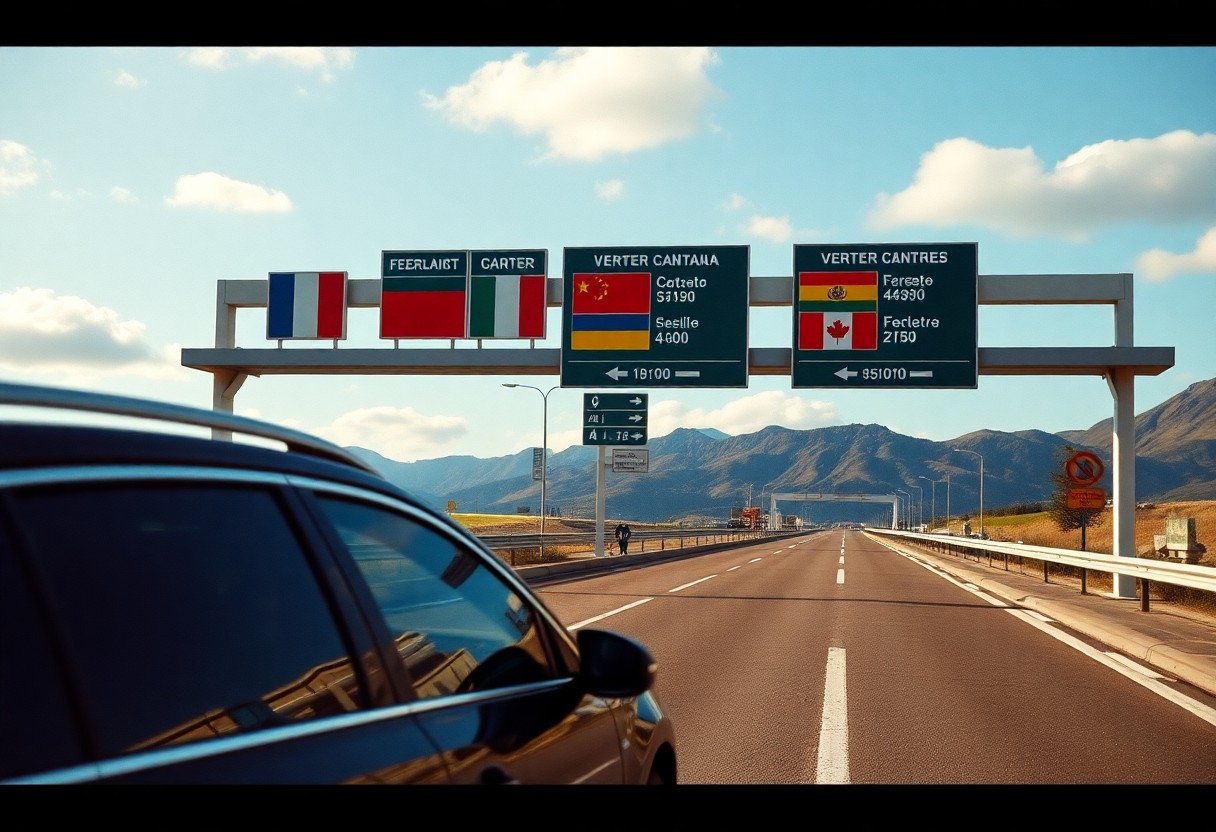Planning for overseas travel in Europe with a rental car is crucial for ensuring a seamless and enjoyable adventure. This process requires meticulous route planning and an in-depth understanding of cross-border regulations. Rental companies often have differing policies regarding travel between European nations, which can greatly affect your journey. While most companies permit travel within Western European countries, there are often limitations concerning trips to Eastern European nations. To avoid any surprises, it’s essential to meticulously examine your rental agreement, as it will provide detailed information about the borders you can cross and any related fees. Before finalizing your booking, confirm that your selected rental company allows travel to all your desired destinations, as non-compliance with cross-border regulations can lead to the voiding of your insurance and hefty penalties. Thus, gathering comprehensive details about these restrictions is key for a successful European road trip.
Key Legal Essentials for Successful Cross-Border Driving in Europe
Before you set off on your European journey with a rental car, it is imperative to meet specific legal requirements and rental company stipulations. Your rental agreement must clearly state that cross-border travel is authorized, and you should ensure you have valid insurance coverage that extends to all the countries on your itinerary. Many rental companies impose restrictions based on geographic zones, and these rules tend to be more rigorous for luxury vehicles. Therefore, understanding these requirements is vital to prevent any legal complications or travel interruptions during your journey.
Secure Your International Driving Permit (IDP) for European Travel
One of the most crucial documents you must obtain for driving in Europe is an International Driving Permit (IDP). This permit is an essential requirement and should be secured in your home country well ahead of your travel plans. The IDP serves as a complement to your regular driver’s license and is mandatorily required in numerous European countries. By acquiring your IDP before your journey, you ensure adherence to local regulations, facilitating a hassle-free driving experience across various nations.
Comprehending Mileage Policies and General Rental Restrictions
When renting a car in Europe, many rental agencies provide vehicles with unlimited mileage options, which is a significant benefit for travelers. However, it’s crucial to recognize that border crossing fees are applicable and can vary significantly, typically falling between €5 and €47.60 per crossing, depending on the rental agency and the specific countries involved. Additionally, due to insurance and security protocols, rental companies often impose specific restrictions for different vehicle categories. Premium brands, including BMW, Mercedes, and Audi, often encounter more limited travel zones compared to standard models, underscoring the necessity to declare your travel intentions in advance to mitigate unexpected expenses.

Decoding Cross-Border Policies of Leading Rental Companies in Europe
When renting a vehicle in Europe, it’s essential to understand that each rental company has unique cross-border policies. Major rental firms generally permit travel between Western European nations, but you will often find that strict restrictions apply for Eastern European countries. These policies can vary considerably depending on the type of vehicle, with luxury cars frequently facing more limitations compared to standard vehicles. Being aware of these policies beforehand will empower you to make informed decisions regarding your rental options and travel itinerary.
Cross-Border Travel Regulations from Avis and Enterprise
Avis and Enterprise provide extensive coverage across Western Europe, allowing their vehicles to be driven in most EU nations, including popular travel destinations like France, Germany, and Spain. However, it’s crucial to be aware that both companies impose specific restrictions on luxury vehicles, particularly when entering Italy. For example, Enterprise charges a daily cross-border fee of 5 euros, with a cumulative maximum fee of 50 euros. By familiarizing yourself with these charges, you can effectively budget for your travel expenses.
Cross-Border Policies of AutoEurope and Hertz
Among the leading rental providers, AutoEurope and Hertz enforce specific country restrictions that are essential for travelers to grasp. For example, taking their vehicles into Eastern European nations such as Albania, Belarus, or Ukraine is strictly prohibited. Additionally, Hertz restricts luxury vehicles and SUVs from entering Italy, while AutoEurope’s policies may vary depending on their local partners. Therefore, it is imperative to declare your travel intentions to your chosen provider before finalizing your rental car booking. Your rental agreement will detail the applicable cross-border fees, which differ by company and destination. For instance, Hertz charges 47.60 euros for crossing from Germany to another approved country, and you may need additional insurance coverage for international travel.
Geographical Limitations to Consider While Traveling
The regulations governing cross-border travel with rental cars across Europe can vary significantly depending on the rental company and the vehicle type you select. Your rental agreement should clearly indicate which countries you are allowed to visit with your rental vehicle. It is vital to keep your rental company informed of your planned route, as crossing borders without proper authorization can void your insurance and lead to substantial penalties.
Countries You Are Permitted to Drive In
Most rental companies allow you to drive freely within Western European countries, encompassing nations like France, Germany, and Spain. Zone 1 countries generally include EU member states in Western Europe, providing the most flexibility for your rental car usage. Your rental agreement will enumerate all the permitted countries specific to your vehicle class, ensuring clarity on where you can travel without issues.
Understanding Restricted Territories and Limitations
Countries that were once behind the Iron Curtain are often subject to strict travel restrictions. Most rental companies prohibit travel to Eastern European nations, including Albania, Belarus, Ukraine, and Russia, due to heightened risks and insurance complexities. Moreover, additional limitations may apply to luxury vehicles and specific brands. High-end vehicles like BMW, Mercedes, and other premium models often have stricter geographical restrictions. If your travel plans encompass multiple countries, it is advisable to opt for a standard vehicle class to maximize flexibility and minimize potential fees or insurance complications.
Vehicle-Specific Limitations Impacting Cross-Border Rental Car Travel
While rental companies may have differing policies, most enforce strict regulations regarding which vehicles are eligible for cross-border travel. Therefore, it is crucial to verify the specific limitations associated with your chosen vehicle class prior to making your booking. These restrictions are implemented to protect valuable assets and ensure compliance with insurance requirements across various European territories.
Flexibility Offered by Standard Rental Cars for Cross-Border Travel
Contrary to common misconceptions, standard rental cars provide the greatest flexibility for cross-border travel. Typically, you can drive standard vehicles throughout most Western European countries without needing special permits. However, it is essential to inform your rental company about your travel plans and be prepared to pay cross-border fees, which may range from 5 to 50 euros depending on the situation.
Restrictions on Luxury Vehicles for Cross-Border Travel
Significant restrictions apply to high-end vehicles concerning cross-border travel. Luxury cars face notable limitations on border crossings, with brands such as BMW, Mercedes, and Audi frequently prohibited from entering Eastern European countries or Italy. Generally, these premium vehicles are confined to Zone 1 countries within Western Europe.
Additionally, if you intend to rent luxury vehicles, anticipate higher security deposits and stricter insurance requirements. Rental companies such as Sixt and Enterprise impose limitations on premium brands like Jaguar, Maserati, and Porsche, allowing them only in select Western European countries. For any border crossings, you will require special permission and potentially additional insurance coverage.
Budgeting for Costs Associated with Border Crossings
It’s vital to consider your budget when planning any cross-border trips in Europe with a rental car. Most rental companies impose additional fees for crossing borders, even within the Schengen Area. Therefore, it is essential to inform your rental company about your anticipated route and obtain written permission before crossing any borders to avoid unexpected charges.
Typical Fees Incurred for Border Crossings
Border crossing fees across Europe generally range from €5 to €50, influenced by the rental company and specific circumstances. For instance, you’ll incur €47.60 with Hertz when crossing from Germany to another permitted country, while Enterprise charges €5 per day, with a maximum of 50 euros for trips originating in Germany. Being aware of these fees will assist in your financial planning while traveling.
Additional Charges to Factor Into Your Travel Budget
At certain borders, you may encounter extra insurance requirements and documentation fees. Your rental company might charge for special permits, particularly when traveling to Eastern European countries or utilizing luxury vehicles. Furthermore, consider the likelihood of higher insurance premiums for specific destinations, especially in Italy or Eastern Europe. Keep in mind that some credit card insurance policies may not cover all European countries, necessitating the purchase of additional coverage from your rental company to ensure peace of mind.

Guidelines for Navigating Ferry Travel with Your Rental Car
Not all rental companies maintain identical policies regarding ferry travel in Europe. While most companies permit ferry travel, it’s vital to confirm the specific rules associated with your rental agreement. Crossing water borders typically necessitates additional documentation and may incur extra fees, so be prepared for these considerations. Additionally, your insurance coverage might change when traveling by ferry, making it essential to understand these aspects before you embark on your journey.
Understanding Company-Specific Ferry Travel Policies
Among the major rental companies, ferry travel policies can vary significantly. Avis and Hertz generally allow ferry travel to approved countries, but it is essential to verify destination restrictions beforehand to avoid potential complications. Conversely, Enterprise and Sixt may require pre-authorization and additional insurance for ferry crossings, which must be clearly stated in your rental agreement to prevent any misunderstandings.
Key Considerations for Breakdown Coverage During Ferry Travel
Another vital factor to contemplate is vehicle breakdown coverage when ferry travel is involved. Most rental companies hold you accountable for vehicle repatriation costs if your car experiences a breakdown after disembarking from a ferry, which can accumulate to thousands of euros, depending on your location and the type of vehicle rented. This responsibility extends beyond mechanical issues; if you encounter an accident or the vehicle becomes unusable while on an island, you are responsible for the expenses required to return the vehicle to its original rental location. Some rental companies offer additional insurance to cover these costs, but it is crucial to secure this coverage before your trip to guarantee adequate protection.
Essential Insights on Cross-Border Driving with Rental Cars
When planning to drive a rental car across European borders, comprehensive research and a clear understanding of specific rules with your rental company are paramount. While you may enjoy the freedom to traverse borders in most European countries, remember that each rental agency has its own policies and fees that are important to consider. The type of rental vehicle you choose can significantly influence your travel options, as luxury cars typically face more restrictions than standard models. Always verify the countries you are permitted to visit, account for any required border crossing fees, and check the regulations concerning ferry travel before embarking on your journey. Diligently reviewing the rental agreement and obtaining an International Driving Permit will further prepare you for a seamless excursion. Your attention to detail in planning is crucial for avoiding complications at border crossings, ultimately leading to a more enjoyable travel experience.
Common Queries Regarding Driving Rental Cars in Europe
Can I drive my rental car to any country in Europe?
No, rental companies implement specific regulations regarding the countries you can visit. The majority allow travel within Western European nations such as France, Germany, and Spain. However, many impose restrictions on travel to Eastern European countries including Albania, Belarus, and Ukraine. Luxury vehicles typically have more stringent limitations. Always review your rental agreement for the allowed countries before setting out on any border crossings.
Will I incur extra fees for crossing borders with my rental car in Europe?
Yes, many rental companies charge border crossing fees. For example, Hertz imposes a fee of 47.60 euros for each border crossing from Germany, while Enterprise charges 5 euros per day (capped at 50 euros) for trips that begin in Germany. These fees apply even when traveling within the Schengen Area. It is crucial to inform the rental company about your travel itinerary and address these fees before attempting any border crossings.
Is it possible to take my rental car on a ferry between European countries?
Yes, most rental companies grant permission for ferry travel as long as your destination country is included on their approved list. However, should your vehicle break down while on an island, you will be held responsible for the costs associated with returning the vehicle to its original rental location. Some firms, such as Hertz, provide coverage for ferry travel through their insurance options (CDW, TP, or SuperCover). Always confirm the specific ferry policies outlined in your rental agreement to avoid unforeseen circumstances.
The Article: Is It Allowed to Drive a Rental Car Across European Borders? appeared first on https://rentacar24.org/
The Article Driving a Rental Car Across European Borders: Is It Allowed? Was Found On https://limitsofstrategy.com



Comments are closed